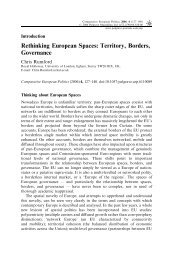Europeanisation, National Identities and Migration ... - europeanization
Europeanisation, National Identities and Migration ... - europeanization
Europeanisation, National Identities and Migration ... - europeanization
You also want an ePaper? Increase the reach of your titles
YUMPU automatically turns print PDFs into web optimized ePapers that Google loves.
Integrating immigrants <strong>and</strong> minorities 87<br />
If we try to pinpoint the motive forces underpinning the development of EU<br />
immigration cooperation <strong>and</strong> integration then a strong intergovernmental impetus<br />
can be identified. The EU has actually been quite useful to member states because<br />
it has allowed them to establish new institutional venues at European level where<br />
the domestic legal <strong>and</strong> political constraints on immigration policy-makers have<br />
been relaxed. <strong>National</strong> governments have thus been able to ‘escape to Europe’ in<br />
a bid to solve problems of international regulatory failure <strong>and</strong> seek new forums<br />
for the pursuit of restrictions on ‘unwanted’ immigration (Hollifield 2000; Stetter<br />
2000). A key element of this response has been the co-option of surrounding states<br />
<strong>and</strong> regions into these processes. For instance, policy developments in southern<br />
Europe – particularly the repressive elements – have been strongly influenced by<br />
the EU acquis (Pastore 2001). For c<strong>and</strong>idate states in central <strong>and</strong> eastern Europe<br />
there have been onerous requirements associated with the incorporation of the EU<br />
acquis into national law as a condition for membership (Lavenex 1999). The result<br />
has been that the uncertainties of political, social <strong>and</strong> economic transformation in<br />
central <strong>and</strong> eastern Europe have also coincided with the development of immigrant<br />
<strong>and</strong> ethnic minorities communities in these countries, as well as longer-st<strong>and</strong>ing<br />
minority populations. The uncertainty elicited by transition <strong>and</strong> the sometimes<br />
onerous economic requirements of EU membership have led to instances of<br />
migrants <strong>and</strong> minorities being scapegoated (see, for instance, Fonseca 1995).<br />
While policy developments could be characterised as lop-sided there is also the<br />
issue of the underlying conceptualisation of the relationship between international<br />
migration <strong>and</strong> its sequels <strong>and</strong> European integration. It is at this point that Jan<br />
Zielonka (2001) entered the fray. He detected a flaw in the exercise of exporting the<br />
EU immigration <strong>and</strong> asylum acquis to the CEECs. He argued that the venture was<br />
predicated on attempts to reconstruct the kinds of ‘hard’ borders that had been<br />
a familiar aspect of the response in ‘older’ immigration countries. The allusion is<br />
to national policies that seek to regulate the flow of international migrants through<br />
centrally directed comm<strong>and</strong> <strong>and</strong> control policies. He argues that this is not<br />
appropriate in central <strong>and</strong> eastern Europe <strong>and</strong> that this defect will become more<br />
apparent as the EU moves eastwards <strong>and</strong> the divergences within the EU, in socioeconomic<br />
terms, for instance, grow larger. He argues that ‘The very notion of a<br />
hard, external border as envisaged by the single market project <strong>and</strong> the regime<br />
of Schengen is basically flawed <strong>and</strong> unlikely to survive the following enlargement’<br />
(p. 508).<br />
In such terms the EU is less of a ‘post-Westphalian state’ with hard <strong>and</strong> fixed<br />
external borders, socio-economic homogeneity, a European cultural identity,<br />
one type of citizenship <strong>and</strong> ‘absolute sovereignty’ regained at European level<br />
(if it ever aspires to be). Instead, he argues that the EU is more of a ‘neo-medieval<br />
empire’ with overlapping authorities, divided sovereignty, varied institutional<br />
arrangements, multiple identities <strong>and</strong> diversified types of citizenship with different<br />
sets of rights <strong>and</strong> duties. The word that might spring to mind when medievalism<br />
is mentioned is feudalism, but for Zielonka it conjures up a vision of a diverse,<br />
heterogeneous <strong>and</strong> normatively desirable future for a wider EU. Zielonka’s point<br />
is that the future enlargement can only magnify, accelerate <strong>and</strong> confirm these trends



